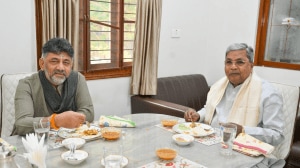Mills and boom
Mahesh Manjrekars film City of Gold wants Mumbai to remember its mill district,then and now.
Once upon a time, Hanuman Theatrenestled in the narrow Chiwda Gallis famous farsaan stores in the Lalbaugs industrial estate areaplayed host to tamasha shows every evening. Soon after the siren signalled the end of the evening shift,the theatre was a packed house. Workers from the textile mills and factories got their daily quota of entertainment. And the theatre,recognised as one of the citys prominent tamasha hubs,dished it out daily for nearly half a century.
The opening sequence of Mahesh Manjrekars recent film City of Gold,recaptures this phenomenon. As actor Resham Tipnis gyrates to a lavni number,the audience of mill workers,in their traditional Gandhi caps,is ecstatic. Once the song is over,the film cuts to the present. The camera pans capturing Mumbais skylinecrammed with high-rises in the Lalbaug and Parel area,which have replaced the citys textile mill belt. Thats the reason I called the Hindi version of the film City of Gold. The way real estate prices are shooting up is unbelievable, says Manjrekar,who has adapted Jayant Pawars play Adhantar. The films Marathi version very simply,yet meaningfully,is called Lalbaug Parel.
In this space-crunched city,erstwhile girangaonsmill areas named after giran which means spinning wheel in Marathiare now rewriting the citys character. Uber-luxe residential areas and upmarket recreational hubs are coming up fast in this mill land in central Mumbai . This is Mumbais latest central business district,just like Nariman Point was in the 80s, says R Karthik,senior vice-president,marketing,Lodha Group. Among others,the group has two luxurious apartments coming up in Mahalaxmi and another in Upper Worliall three on former mill lands.
The burst of tony apartments in central Mumbai can be termed a new phase in the island citys economic progressionafter the cotton boom and over a century-long mill culture. The citys transformation from a trading town to an industrial and manufacturing centre begun in 1854 when Cowasji Nanabhai Davar set up the Bombay Spinning Mill at Tardeo, says urban historian Sharada Dwivedi,who has co-authored Bombay: The City Within.
By the end of the 19th century,the number of mills in the city had touched 136. Migrant workers flocked from drought-ridden districts of Maharashtra,Gujarat and the Konkan coast,giving the city a multi-dimensional character. Their presence created a rich social fabric. At least seven cinema halls around here used to show Marathi films. There were several theatres dedicated to tamasha,lavani,bharud and other folk performances, recalls Datta Ishwalkar,leader of the Girni Kamgar Sangharsh Samiti,a trade union in the textile industry. There were regular drama and bhajan competitions while community kitchens called khanawal served special food from Malwan,Konkan and Ghat regions. It also became a breeding ground for literary work. The pathos of mill workers found place in literature and poetry. It inspired a poet like Namdeo Dhasal, says Dwivedi.
Nearly three decades after the January 1982 strike of 2.5 lakh mill workers demanding pay hike,such cultural activities have become part of urban lore. Proof: the transformation of Hanuman Theatre,which had started in 1943 in a makeshift tent. Rechristened as New Hanuman Theatre in 1994,its now a spacious marriage reception hall. Its stage has been replaced with a gaudy podium,meant to showcase the newly-wedded couple. Such change was unavoidable as the area surrounding the theatre underwent a change after the closure of mills, says its 70-year-old owner Madhukar Nerale. He still works passionately for the welfare of tamasha artistes of the state.
However,the theatres makeover is minor. Mumbais millswhich had collectively occupied 600 acres in the heart of the citynow showcase gigantic shopping malls and towering high-rises. And at the centre of this are Lalbaug,Parel,Worli and Sewri. Change is inevitable and constant. However,I am interested in re-envisaging of spaces, says Anupa Mehta,art consultant and writer,whose grandfather owned the Mathuradas Mill in Lower Parel. She runs an art galley,The Loft,in the mill compound which also houses the Blue Frog,one the citys best night-out destinations for the last three years.
The rapid development of modern life spaces in this area has exposed the citys laxity in upgrading the infrastructure. Most mills were surrounded by slums where the approach roads were narrow and infrastructure was bad. Luxury apartments are now coming up there without mitigating these problems, says Dwivedi. Madhushree Dutta,the director of the film Seven Islands and a Metro,recalls that the landscape was very different just four years back when she made her film. When I look around,I feel as if I had filmed it a century back, she says.
However,Gayatri Ruia,director of business development,Palladium,the brand new luxury destination at High Street Phoenix mall,which has came up in place of once burnt-down Phoenix Mills,sounds nonchalant. This is Mumbai. But the space has worked for us and the area is only going to grow in the coming years, she says. Like Ruia,Karthik too is optimistic. In Mumbai,infrastructure follows development, he says. He predicts that in the coming years,the skyline will change,with more high-rises making the world-class lifestyle available in Mumbai. Both Ruia and the Lodha group are keen to acquire more mill land in the area.
And while almost all mill culture is lost,some remnants linger on. In the New Hanuman Theatre compound,there is a shrine of Mari Aai,built in the memory of a tamasha artist who used be possessed by Devi. At India United Mills,a museum dedicated to mills and workers is coming up. How can you erase legacies? says Mehta.



- 01
- 02
- 03
- 04
- 05




























